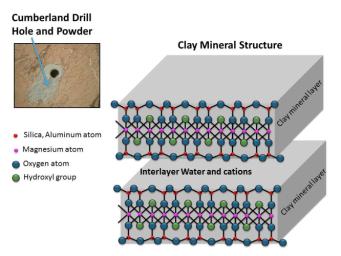
|
Clay Mineral Structure Similar to Clays Observed in Mudstone on Mars
- Click the image above for a larger view
- Full-Res JPEG (960 x 720) (87.5 kB)
- Full-Res TIFF (960 x 720) (2.1 MB)
Caption:
Clay minerals are composed of layers. Water and cations (positive-charged ions) can be stored between these layers. This schematic shows the atomic structure of the smallest units that make up the layers and interlayer region of clay minerals. This structure is similar to the clay mineral in drilled rock powder collected by NASA's Curiosity Mars rover and analyzed by the rover's Chemistry and Mineralogy (CheMin) and Sample Analysis at Mars (SAM) laboratory instruments. The rover drilled into rock targets "Cumberland" (in upper left insert) and "John Klein," both in the Sheepbed mudstone at Yellowknife Bay, Gale Crater, Mars.
Background Info:
NASA's Jet Propulsion Laboratory, Pasadena, Calif., manages the Mars Science Laboratory Project and the mission's Curiosity rover for NASA's Science Mission Directorate in Washington. The rover was designed and assembled at JPL, a division of the California Institute of Technology in Pasadena.
More information about Curiosity is online at http://www.nasa.gov/msl and http://mars.jpl.nasa.gov/msl/ .
Cataloging Keywords:
| Name | Value | Additional Values |
|---|---|---|
| Target | Mars | |
| System | ||
| Target Type | Planet | |
| Mission | Mars Science Laboratory (MSL) | |
| Instrument Host | Curiosity Rover | |
| Host Type | Rover | |
| Instrument | Chemistry & Camera (ChemCam) | Sample Analysis at Mars (SAM) |
| Detector | ||
| Extra Keywords | Color, Crater, Water | |
| Acquisition Date | ||
| Release Date | 2013-12-09 | |
| Date in Caption | ||
| Image Credit | NASA/JPL-Caltech/MSSS | |
| Source | photojournal.jpl.nasa.gov/catalog/PIA17598 | |
| Identifier | PIA17598 | |
